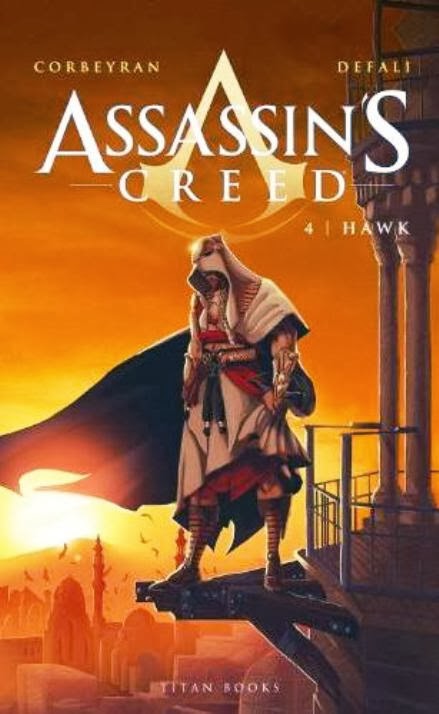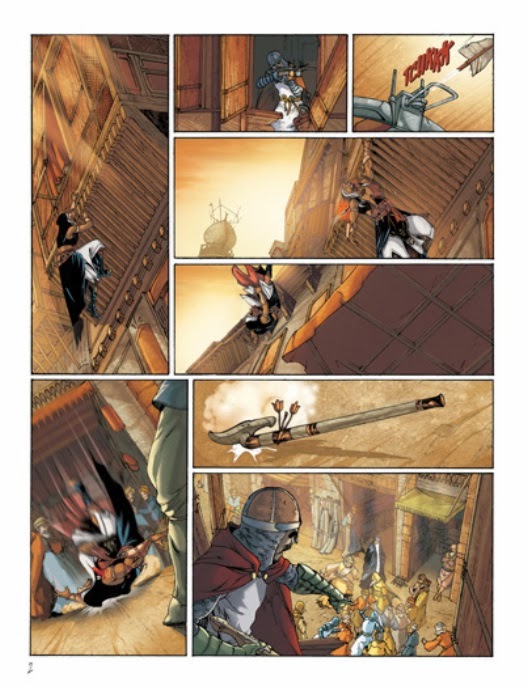 As a player — and fan — of the Assassin’s Creed on the Xbox 360, I was delighted to have the opportunity to review graphic novels based on the game.
As a player — and fan — of the Assassin’s Creed on the Xbox 360, I was delighted to have the opportunity to review graphic novels based on the game.
The first collection, The Ankh of Isis Trilogy (Titan Books) comprises three sequential tales called, repectively, Desmond, Aquilus and Accipter, named after characters in the narrative. Desmond opens in the present day at St. Erembert Psychiatric Hospital. Within the first two pages, we have a murder and a dramatic escape by a man known as Subject 16. Cut to 3rd Century AD, somewhere within the Roman empire, and we see a familiar cloaked figure (the eponymous assassin) on horseback riding towards a Roman army encampment. In this era, the assassin is called Aquilius and he has ostensibly come the Roman general Gracchus to help him fight against the Germani. The general, however, suspects him of having come to kill him. When the general stabs him, Aquilus’s psychic operating system, returns him to his genetic descendant, a man called Desmond Miles.
In the Assassin’s Creed stories and game the operating system is the animus, a kind of time machine that links an historical person with a present day one through their genetic codes.
Desmond is next sent to the Holy Land in the year 1190, the setting for the first Assassin’s Creed computer game. In his manifestation as Altair, he has an encounter with his tutor, who is protecting a certain artefact sought by the Abstergo, the present day equivalent of the Knights Templar. The tutor’s statement that “So long as men are able to enjoy free will, there will be no peace” hints at the purpose of these missions and the search for the various artefacts scattered across the globe.
We discover that the Abstergo have plans for world domination, and only the order of assassins stand against them. Readers unfamiliar with the game may have some trouble initially figuring out exactly what’s going on, but with a little patience, all becomes clear in a fabulous graphic novel that brings together elements of science fiction, fantasy, historical epic and political thriller.
Parts two and three continue the narrative, with Desmond/the assassin travelling to different historical locations, from Gaul to the Holy Land. He not only has to handle his mission to retrieve the objects hidden in time, but in the present day he is confronted with a relentless enemy pursuing the same goal.
The graphic novel’s colorist, Raphael Hedon, uses hot hues to evoke the historical period, and cool ones for the present day setting, though with devices such as warm colors sometimes showing through the panoramic windows of the skyscraper housing the lab. Artist Djillali Defali’s landscapes and architecture are beautifully rendered and the artwork at times reminded me of the Italian comic book master, Milo Manara. Together with writer, Corbeyran, the trio create a beautifully evocative illustrated story that is complex in narrative structure and cinematic in style.
 There were, however, two elements of the narrative I was less keen on. The first is about the scientist, Lucy, who seems to be a karate expert and is given to kicking her foes into submission. That element felt more like a comic book trope and seemed to me unnecessary, given that there’s plenty of action in the book as is; it makes Lucy seem less plausible as a character. The second is in the third part and involves a device that seems to have been consciously or unconsciously borrowed from Star Wars. But please don’t let my small carps stop you reading…you’ll find plenty to enjoy here and, besides, you may prefer your sexy scientists to be martial arts experts!
There were, however, two elements of the narrative I was less keen on. The first is about the scientist, Lucy, who seems to be a karate expert and is given to kicking her foes into submission. That element felt more like a comic book trope and seemed to me unnecessary, given that there’s plenty of action in the book as is; it makes Lucy seem less plausible as a character. The second is in the third part and involves a device that seems to have been consciously or unconsciously borrowed from Star Wars. But please don’t let my small carps stop you reading…you’ll find plenty to enjoy here and, besides, you may prefer your sexy scientists to be martial arts experts!
The first volume ends heralding the next mission – with an image of the Sphynx.
The second volume is Part 4: Hawk, again named after one of the characters. The historical events take place in 14th Century Egypt. The search is on for another object – this time, the scepter of the Egyptian goddess, Asset. In the present day, Jon Hawk enters the animus to become the assassin El Cakr in ancient Egypt. Hawk is awaiting an operation to replace a damaged eye with a camera, but his original eye, which the hospital has put in storage, has been stolen. Hawk is also having trouble physically when he is using the animus, not to mention the machinations of the enemies who are now on the hunt for the scepter themselves. This volume’s colorist Cyril Vincent, uses a somewhat brighter, unified palette, and every bit as magical in its own way as Hedon’s from the first trilogy.
 The Assassins Creed graphic novels feature some real historical characters and draw on stories and myths from ancient times which greatly enrich the tales. Book 4 ends on a cliff-hanger. You’ll want to stick with the series as it develops – great story and superb artwork make for riveting reading. And while I would love to continue playing the Assassin’s Creed game, especially after reading the graphic novels, my Xbox is totally fried, so I’m stuck with my own cliff hanger…
The Assassins Creed graphic novels feature some real historical characters and draw on stories and myths from ancient times which greatly enrich the tales. Book 4 ends on a cliff-hanger. You’ll want to stick with the series as it develops – great story and superb artwork make for riveting reading. And while I would love to continue playing the Assassin’s Creed game, especially after reading the graphic novels, my Xbox is totally fried, so I’m stuck with my own cliff hanger…
—————————————————————————————————————————————————
John Dodds is the author of The Kendrick Chronicles crime novels (Bone Machines and Kali’s Kiss ) and is currently completing the third novel in the series, Babylon Slide. Under a pseudonym, JT Macleod, has written a collection of historical/paranormal/erotic/romance stories called Warriors and Wenches, as well as the first novel in YA steampunk superhero series which he is shopping around agents. You can hear some of his short stories on podcasts such as Tales to Terrify, Starship Sofa and others. John also blogs for Amazing Stories Magazine.
Subscribe to Adventures in SciFi Publishing podcast on: iTunes | Stitcher Radio (Android users) | RSS | Website RSS


















Speak Your Mind